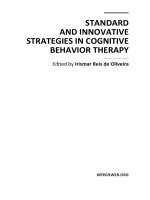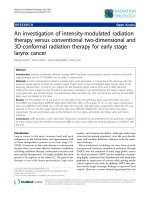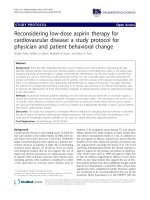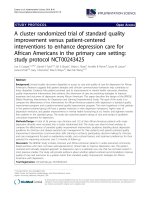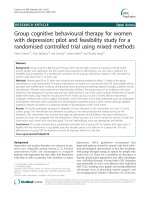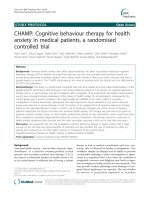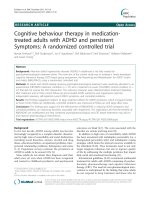Culturally specific versus standard group cognitive behavioral therapy for smoking cessation among African Americans: An RCT protocol
Bạn đang xem bản rút gọn của tài liệu. Xem và tải ngay bản đầy đủ của tài liệu tại đây (344.94 KB, 9 trang )
Webb Hooper et al. BMC Psychology 2013, 1:15
/>
STUDY PROTOCOL
Open Access
Culturally specific versus standard group
cognitive behavioral therapy for smoking
cessation among African Americans: an RCT
protocol
Monica Webb Hooper1*, Ramona Larry2, Kolawole Okuyemi3, Ken Resnicow4, Noella A Dietz2,
Robert G Robinson5 and Michael H Antoni1
Abstract
Background: African American smokers experience disproportionately higher rates of tobacco-related illnesses
compared to Caucasians. It has been suggested that interventions targeted to specific racial/ethnic groups
(i.e., culturally specific) are needed; however, the literature examining the efficacy of culturally specific interventions
is equivocal. Moreover, there are few descriptions of methods used to create these interventions. The main aim of
this study is to test the efficacy of a culturally specific smoking cessation intervention among African Americans.
Methods/Design: A 2-arm randomized controlled trial (RCT) will be conducted to assess the efficacy of a culturally
specific group cognitive behavioral therapy (CBT), compared to standard group CBT among treatment-seeking smokers
from the community. Participants in both conditions receive the transdermal nicotine patch (TNP) for 8-weeks. We
intend to randomize at least 247 adult smokers who self-identify as African American into the trial. Enrolled participants
are block randomized into one of two groups: Standard group CBT (control) or a culturally specific group CBT (CS-CBT).
Groups are matched for time and attention, and consist of eight sessions. The primary outcome variable is 7-day point
prevalence abstinence (7-day ppa). Smoking status is assessed at the end-of-counseling (EOC), and 3, 6, and 12-month
follow-ups, with self-reported abstinence verified by saliva cotinine. We hypothesize that the CS-CBT condition will
produce significantly greater smoking cessation rates compared to the control condition. We also expect that this
effect will be moderated by acculturation and ethnic identity, such that the CS-CBT will show the greatest effect on
cessation among participants who are less acculturated and have greater ethnic identity.
Discussion: Answering the fundamental question of whether culturally specific interventions lead to incremental
efficacy over established, evidence-based approaches is of utmost importance. This study will have implications for the
development and implementation of smoking cessation interventions among African Americans and other racial/
ethnic minority groups.
Trial registration: NCT01811758
Keywords: Smoking cessation, African Americans, Culturally specific, Cognitive behavioral therapy
* Correspondence:
1
Sylvester Comprehensive Cancer Center, University of Miami, PO Box
248185, Coral Gables, FL, US
Full list of author information is available at the end of the article
© 2013 Webb Hooper et al.; licensee BioMed Central Ltd. This is an Open Access article distributed under the terms of the
Creative Commons Attribution License ( which permits unrestricted use,
distribution, and reproduction in any medium, provided the original work is properly cited.
Webb Hooper et al. BMC Psychology 2013, 1:15
/>
Background
Significance
In 2011, 19.4% of African American adults were current
smokers (CDC 2012). Although comparable to the overall
population, the prevalence among low-income African
Americans is notably higher (40%-60%) (Delva et al.
2005). In addition, African American smokers experience
disproportionate rates of smoking-related disease and
death compared to other racial-ethnic groups (Park et al.
2011; American Cancer Society 2007). Smoking characteristics differ between African Americans and Caucasians,
some of which may help explain these disparities in health.
It is known that compared to Caucasian smokers, African
Americans are more likely to smoke mentholated brands,
have higher serum cotinine concentrations per cigarette
smoked (Caraballo et al. 2011), are less likely to use
evidence-based cessation treatments and are less likely to
achieve cessation (Fu et al. 2008; Trinidad et al. 2011).
The latter points may in part be attributable to the lower
likelihood of receiving appropriate smoking cessation
advice from providers (Lopez-Quintero et al. 2006) and
the failure of prior interventions to address ethno-cultural
factors that may limit their effectiveness. Needed are
evidence-based interventions that specifically target
African American smokers. The purpose of this study is
to evaluate the incremental efficacy of addressing unique
ethno-cultural factors within the context of an established
cognitive behavioral therapy for smoking cessation in a
sample of African Americans.
Cognitive behavioral therapy for smoking cessation
Cognitive behavioral therapy (CBT) for smoking cessation and relapse prevention have established efficacy
(Fiore et al. 2008; Song et al. 2010). CBT for smokers includes a focus on coping skills training, and has efficacy
at least comparable to pharmacotherapy (Fiore et al.
2008), with greater cost-effectiveness (Cromwell et al.
1997). Group-based CBT is particularly efficacious, and
provides social support, positive reinforcement, psychoeducation, and cognitive behavioral strategies for coping
and stress management (Stead & Lancaster 2005). Little
previous research has examined group smoking interventions with CBT components among African American.
Two studies found evidence for efficacy when compared
to assessment only and minimal self-help (Murray et al.
2001; Knight 2004). Only one trial compared CBT to a
time-and-attention matched control condition (Webb et al.
2010), which was the first study to demonstrate that CBT
was causally related to smoking cessation among African
Americans. However, because the intervention was delivered using a standard (i.e., non-culturally specific)
format, it did not address the unique ethno-cultural
characteristics of African American smokers. Indeed, this
standard intervention had lower efficacy among the
Page 2 of 9
subgroup of smokers with traditional African American
values and cultural practices (Webb Hooper et al. 2012).
Culturally specific smoking cessation interventions
Culturally specific approaches to behavior change integrate race, ethnicity, social factors, culturally traditional
norms and values, and behavior patterns into the core of
interventions. Such interventions have been referred to
using various terms, including culturally sensitive, targeted, tailored, and competent. This study uses the term
culturally specific to convey that the intervention is designed for a specific ethno-cultural group (i.e., African
American smokers), yet may not apply equally to all members. Models of culturally specific interventions
targeting African Americans emphasize the significance
of framing the content and presentation within a context that is appropriate for the group (Kreuter et al.
2002; Resnicow et al. 1999). Resnicow and colleagues
(1999) described two components of culturally sensitive
interventions, surface and deep structure. The goal of
surface structure is to adapt the presentation of interventions to facilitate acceptability, receptivity, and capture attention (e.g., race-matched images). In contrast,
deep structure adapts the intervention content by addressing meaningful historical, socio-cultural, environmental, and psychological factors (e.g., collectivism,
religion, and racism). The intervention in the current
study includes both surface and deep structure
elements.
More research is needed to test culturally specific interventions for African American smokers. A few studies
have compared culturally specific self-help materials to
standard control groups, and found a preference for the
culturally specific booklets (Webb 2009; Orleans et al.
1998) and greater quit attempts among participants in
the culturally specific condition (Orleans et al. 1998;
Nollen et al. 2007). These studies did not find smoking
cessation differences between conditions, which is the
primary goal of most interventions. It is possible that
adapting existing interventions with demonstrated efficacy among African American smokers will add incremental efficacy to outcomes. This assertion is supported
by previous research in the psychotherapy literature
indicating that culturally specific interventions are more
effective than traditional interventions, and that this
effect is positively associated with the extent of specificity (Smith et al. 2011).
Consideration of ethno-cultural individual differences
Because race is not equivalent to a monolithic culture,
culturally specific smoking cessation interventions may
benefit some smokers, but not others (Webb 2008). It is
important to consider individual differences in acculturation (i.e., the extent of engagement in one’s traditional
Webb Hooper et al. BMC Psychology 2013, 1:15
/>
cultural beliefs, values, and practices versus adoption of
the dominant culture) and ethnic identity (i.e., identification and affiliation with one’s ethnic group), as these
factors may affect outcomes. African American smokers
are likely to be less acculturated compared to African
American non-smokers (Klonoff & Landrine 1999;
Landrine & Klonoff 1994). Acculturation is also predictive of culturally specific intervention receptivity.
Webb (2008) found that less acculturated African
American smokers preferred culturally specific written
materials, while those higher on acculturation preferred
standard materials. Ethnic identity also has the potential to influence outcomes following culturally specific
interventions. Resnicow et al. (2009) found that tailoring a self-help nutrition newsletter on ethnic identity
resulted in improved fruit and vegetable intake among
Afrocentric African Americans. No previous research
has examined the role of ethnic identity in culturally
specific interventions among smokers. This study, however, will explore the possibility that culturally specific
CBT will be more efficacious among smokers with
greater ethnic identity.
The present study
This study will address an important gap in the literature by answering a fundamental question regarding the
use of culturally specific interventions among African
American smokers in a randomized controlled trial.
Previous research suggests a positive role of cultural
specificity for process outcomes in self-help trials, but
no studies have demonstrated a significant effect on
smoking cessation within more potent interventions
(e.g., group CBT). We hypothesize a main effect of cultural specificity, such that CS-CBT will result in greater
smoking cessation rates compared to standard CBT. We
also expect to find a main effect of time, such that the
CS-CBT condition will result in greater cessation rates
through 12-months. We do not anticipate an intervention × time interaction. Our exploratory analyses will
consider the moderating roles of acculturation and
ethnic identity on smoking cessation outcomes. Specifically, we expect that less acculturated participants (i.e.,
highly engaged in traditional African American culture)
and those with greater ethnic identity will show the
greatest cessation rates if they are in the CS-CBT
condition.
Design and method
This phase 1 efficacy study is a 2 (intervention) × 4
(time) mixed factorial design with cotinine-confirmed
cessation as the primary outcome. Factor 1 is the type of
intervention: culturally specific CBT (CS-CBT) versus
standard CBT (control), both supplemented by 8-weeks
of transdermal nicotine patch (TNP) therapy. CBT in
Page 3 of 9
both conditions consists of cognitive and behavioral
strategies guided by evidence-based smoking cessation
and relapse prevention models (Marlatt & Gordon 1985).
The key difference between conditions is whether the
intervention is culturally specific. The culturally specific
components (e.g., discussion of race and smoking, racematched clinicians, and an emphasis on religion/spirituality) are those described in the literature and our prior
research. Factor 2 is time: End-of-counseling (EOC), and
3, 6, and 12-month post counseling assessments. This
study includes a controlled, internally valid, experimental
test of the efficacy of CS-CBT among African American
smokers. Figure 1 illustrates the flow of participants
through the trial.
Participants and recruitment
Participants will be 247 African American tobacco
smokers recruited from the community. We developed
a comprehensive recruitment plan, consisting of advertisements on public transportation, partnering with
healthcare organizations with large racial minority
clientele, and street outreach (directly talking with
people in predominantly Black neighborhoods and
visiting local businesses). Participants are considered
eligible if they: (1) self-identify as African American;
(2) currently smoke ≥ 5 cigarettes/day or have an
expired CO level of ≥ 8 ppm; (3) are ages 18–65; (4) are
able to read 5th-6th grade English; (5) have permanent
contact information; (6) are able to attend clinic
sessions (transportation costs are reimbursed); and (7)
are motivated to quit smoking (rated as a 6 on a 1–10
scale). We exclude those who are currently receiving
any type of cessation, alcohol or illicit drug treatment,
pregnant/breastfeeding, or diagnosed with an acute
cardiac or respiratory condition. Ineligible participants
are referred to the Florida QuitLine.
Randomization
Eligible participants are randomly allocated using a 1:1
ratio in blocks of 50 to one of the two conditions, CSCBT or control. The unit of randomization is the individual. Eligible participants receive a tentative random
assignment and are scheduled for an orientation session, with only those who attend and provide written
informed consent enrolled in the study. We schedule
up to 25 participants per group to ensure 8–12 tentatively assigned participants are enrolled/consented into
the study.
Procedures
Prior to orientation, welcome letters containing the
schedule of group sessions and directions are mailed.
Reminder calls are placed to facilitate continued interest
Webb Hooper et al. BMC Psychology 2013, 1:15
/>
Page 4 of 9
Assessed for eligibility
Ineligible/Disqualified
Eligible and
Scheduled for orientation
Did not attend orientation
Randomized
Standard Cognitive
Behavioral Therapy
Culturally Specific Cognitive
Behavioral Therapy
End-of-counseling Assessment
3-Month Follow-Up
6-Month Follow-Up
12-Month Follow-Up
Figure 1 RCT flowchart. Illustration of study design and participant flow.
in the study. Participants attend orientation, eight clinic
sessions, and 3, 6, and 12-month follow-up assessments.
Interventions
Orientation and intervention sessions
Participants attend a 60-minute orientation before the
start of the clinic sessions. They learn the background,
purpose, format, and procedures of the study; provide
informed consent; complete baseline measures; learn
about TNP therapy and receive their first patch (the
remainder of the patches are provided throughout active
treatment); and provide breath carbon monoxide (CO)
and saliva samples for cotinine analysis. We also cover
smoking and health, self-motivation, and goal setting. In
the CS-CBT condition, we explain that the group is
framed within a cultural context, designed to emphasize
African American race/ethnicity and cultural issues.
In accordance with previous research (Webb et al.
2010; Brandon et al. 1995) participants in both conditions are asked to reduce their smoking by one-half on
the day before the first clinic session and to abstain
completely from smoking on the first day of actual
group treatment (session 1). They are also instructed to
begin patch use on the morning of the first day of treatment (session 1; the target quit day) with the patch provided at orientation. This aspect of the protocol is
unique from other cessation approaches that set the quit
day several weeks post beginning the intervention. However, this evidence-based protocol has been successful in
previous studies [e.g., Webb et al. 2010; Brandon et al.
Webb Hooper et al. BMC Psychology 2013, 1:15
/>
1995] and is also the format we use in our ongoing cessation clinic. Participants who do not quit on the target
day are encouraged to make a quit attempt by the third
treatment session.
Participants in both conditions meet eight times over
four consecutive weeks. Four sessions occur during week
1, two during week 2, and one weekly booster session
during weeks 3 and 4. Depending on group size, the duration of sessions is 90–120 minutes in both conditions.
We anticipate 8–16 participants per group. Co-therapy
pairs of masters or bachelor’s level interventionists are
trained to conduct sessions for one condition (CS-CBT
or control) and supervised by the principal investigator
(PI). Groups are held in a laboratory-based clinic. Incentives include $40 at session 1, $20 at session 5, $50 at
session 8, $50 at the 3-month assessment, $70 at the 6month assessment, and $70 at the 12-month assessment.
Participants also receive $5 per session for transportation/
parking and light refreshments at each session.
Intervention conditions
(1)Group cognitive behavioral therapy for smoking
cessation (control): The intervention in this
Page 5 of 9
condition is based on standard cognitive and
behavioral strategies, supplemented by TNP therapy.
A previous study testing this intervention in an
African American sample found 7-day ppa rates of
70% at the EOC, 52% at the 3-month follow-up, and
46% at the 6-month follow-up post counseling
(Webb et al. 2010). Session content is displayed in
Table 1, and includes the benefits of quitting, nature
of nicotine addiction, nicotine withdrawal,
identification of “high risk” situations, motivation,
coping skills, stress and negative affect, decision
making, alcohol use, weight control, social support,
behavioral contracting, and relapse-prevention. To
enhance the external validity of the intervention, the
co-therapy team is not race-matched (at least one
interventionist is non-African American/Black).
(2)Culturally specific group cognitive behavioral
therapy for smoking cessation (CS-CBT): The
intervention is the standard CBT program with an
emphasis on African American culture (Table 1).
Each session focuses on specific aspects of
traditional African American culture. The CS topics
were selected based on our previous qualitative
research (Webb et al. 2007), and established models
Table 1 Overview of the interventions
CBT
CS-CBT
Orientation Study explanation, structure of sessions and TNP, informed
consent, health and smoking, research participation, goal setting,
baseline assessment, breath carbon monoxide (CO) and saliva
samples.
Same as in the CBT condition. Race and smoking, views on
research participation, distrust for biomedical research, concerns
about nicotine replacement, goal setting, baseline assessment,
breath CO and saliva samples, race-matched clinicians (RMC).
Session 1
Review quit plan, positive reinforcement (PR), reasons for quitting,
nicotine addiction, introduction to coping response training
model, smoking and motivation, TNP use, plan for next 24 hours,
behavioral contracting (BC), CO.
Standard CBT. Meaning of being African American, tobacco and
African Americans, menthol, RMC.
Session 2
Review quit plan progress, PR, benefits of quitting, coping skills,
plan for next 24 hours, BC, CO.
Standard CBT. Spirituality and religion in the African American
community, RMC.
Session 3
Review quit plan progress, PR, stress management, alcohol and
smoking, high cost of smoking, plan for next 48 hours, perceived
benefits of quitting, BC, CO.
Standard CBT. Stressors unique to African Americans,
discrimination and racism, deep breathing exercises, co-morbid
addiction, little cigars and blunt use, RMC.
Session 4
Review quit plan progress, PR, negative affect and smoking,
cognitive restructuring, decision making, plan for next 72 hours,
BC, CO.
Standard CBT. Traditional African American values, buddy system,
deep breathing exercise, RMC.
Session 5
Review quit plan progress, PR, review personal high-risk situations,
relapse prevention, responding to lapses, plan for next 72 hours,
BC, CO.
Standard CBT. Mood and depression among African Americans,
deep breathing exercise, RMC.
Session 6
Review quit plan progress, PR, individual high-risk situations, noted Standard CBT. Weight and African Americans, smoking and weight
benefits of quitting, weight and smoking cessation, minimizing
concerns (super-gainers), minimizing weight gain (physical activity
weight gain, relapse prevention, plan for next 7 days, BC, CO.
with limited resources, healthy food choices within soul food diet,
recipes), deep breathing, RMC.
Session 7
Review quit plan progress, PR, planning for group termination, a
new lifestyle, social support, plan for next 7 days, BC, CO.
Session 8
Standard CBT. Body as a temple, resources, mobilizing the African
Review quit plan progress, PR, reflect on group experience,
long-term trip-ups, review of coping response training, withdrawal, American community against the tobacco industry, deep
breathing exercise, RMC.
relapse prevention, TNP schedule, follow-up procedures, BC, CO
and saliva samples.
Note: Topics that are not explicitly culturally specific are discussed within this context.
Standard CBT. Life in your neighborhood, environmental
influences, gaining freedom from smoking, deep breathing
exercise, RMC.
Webb Hooper et al. BMC Psychology 2013, 1:15
/>
e.g. (Robinson et al. 1992). Topics include deep
structure: Distrust for biomedical research; race and
smoking, race-based statistics related to nicotine
replacement/medication concerns; religion/
spirituality; family/collectivism; unique stressors;
racism/discrimination, depression among African
Americans; co-morbid addiction; neighborhood/
environmental influences; targeted tobacco
marketing; menthol cigarettes; race-specific weight
issues and concerns; and working as a community
against the tobacco industry. Surface structure is
also included: Interventionists are race-matched,
second-person phrases (e.g., us, we) are used
throughout, and the daily agenda includes African
American quotations or proverbs.
Transdermal nicotine patch therapy (TNP)
TNP has demonstrated efficacy in multiple trials
(Silagy et al. 2000), is available over-the-counter, and is
safe and effective for smoking cessation (Shiffman et al.
2002) without monitoring by a physician. Consistent
with (Webb et al. 2010) and (Fiore et al. 2008), participants are prescribed four weeks at 21 mg, two weeks at
14 mg, and two weeks at 7 mg (Doses are adjusted
according to smoking history).
Training and intervention fidelity
The interventionists are trained by the PI. Training
includes relevant readings (smoking, cessation and
relapse prevention, cognitive behavioral therapy, motivational interviewing), observation of two therapy
groups, minimal contributions in the role of therapist,
and finally, fully conducting sessions with weekly PI
supervision. Detailed intervention manuals are followed
closely and participants receive a daily agenda. Interventionists do not cross over to prevent contamination.
Most sessions are audio recorded and will be coded
using a 10-item scale for adherence [see Webb et al.
2010] by two independent evaluators. Codes will be
transformed into percentages indicating the degree of
protocol adherence.
Measures
Baseline
Measures include demographics, smoking history, and
nicotine dependence (Heatherton et al. 1991) (Table 2).
We also assess perceived stress (Cohen et al. 1983), depressive symptoms (Radloff 1997), and decision making.
Particularly relevant for African American smokers,
we include assessments of acculturation (Klonoff &
Landrine 1999), ethnic identity (Davis et al. 2010), expectancies for culturally specific interventions, and perceived ethnic discrimination (Landrine et al. 2006). We
also record height and weight. Participants also complete
Page 6 of 9
an “In Case I Move Form” as a method of tracking
participants via relatives or friends.
Intra-treatment
Attendance, TNP utilization, and weight are recorded
at each session. Participants also self-report, via
monthly telephone follow-ups, utilization of 14mg, and
7mg patches across the full 8-weeks. The Minnesota
Withdrawal Scale (Hughes & Hatsukami 1986) is administered as an indicator of nicotine withdrawal, and
the Questionnaire of Smoking Urges-Brief (Sanderson
Cox et al. 2001) assesses urges to smoke.
End-of-counseling
Participants evaluate the intervention, using the Intervention Rating Questionnaire (Webb et al. 2010), and
complete measures of perceived stress, depressive symptoms, nicotine withdrawal, and therapist satisfaction
(Oei & Green 2008) (Table 2). Self-reported smoking
status since the target quit date is assessed using the
time-line follow-back (TLFB) procedure, which reconstructs the participant’s smoking pattern since the target
quit date (Brown et al. 1998; Sobell & Sobell 1992).
Follow-up (3, 6, and 12-months)
Measures completed at each “reunion meeting” include
the TLFB (Brown et al. 1998; Sobell & Sobell 1992),
smoking status and use of other tobacco products and
pharmacotherapy, and weight (Table 2).
Bio-verification
Smoking status is confirmed biochemically. Cotinine
assays are collected at the orientation meeting (for a
baseline level before cessation) and at the in-person 3, 6,
and 12-month follow-ups (for self-reported quitters).
Cotinine samples, using a cut point of 7 ng/ml, will determine smoking status (Abrams et al. 1987; Etter et al.
2000). The CBT protocol requires that breath carbon
monoxide (CO) samples be collected at each session to
provide participants with immediate feedback. Breath
CO readings of at least 8 ppm will distinguish smokers
from nonsmokers at the EOC, and have been found
to be a sensitive method of determining smoking
status (Benowitz et al. 2002). As recommended by
(Benowitz et al. 2002), follow-up abstinence rates will
be calculated separately for both self-report and biochemical findings.
Outcome variables
The primary outcome variable is 7-day ppa, assessed
at the EOC, 3, 6, and 12-month follow-ups. Seven-day
ppa refers to no smoking (not even a puff ) for the
past seven days (Hughes et al. 2003). Secondary outcomes include 24-hour (no smoking in the past day)
Webb Hooper et al. BMC Psychology 2013, 1:15
/>
Page 7 of 9
Table 2 Constructs and measures
Assessment points
Measure
Baseline
Intra-treatment
End-of-counseling
3-month
follow-up
6-month
follow-up
12-month
follow-up
Attendance
✓
✓
✓
✓
✓
✓
Demographics
✓
Smoking history
✓
Nicotine dependence
✓
Height
✓
Weight
✓
✓
✓
✓
✓
✓
Perceived stress
✓
✓
Depressive symptoms
✓
✓
Acculturation
✓
Ethnic Identity
✓
Expectancies for culturally specific Interventions
✓
Decision making
✓
Perceived ethnic discrimination
✓
✓
✓
✓
✓
✓
✓
✓
✓
✓
Nicotine withdrawal
✓
✓
Smoking urges
✓
✓
TNP use
✓
✓
Intervention ratings
✓
Time-line follow-back (smoking pattern)
✓
✓
Therapist satisfaction
Carbon monoxide
✓
Cotinine*
✓
✓
✓
Note: *At baseline, saliva for cotinine is collected from all participants. Cotinine samples are not collected at the EOC because participants are still using nicotine
replacement. At follow-ups, saliva for cotinine is collected from self-reported abstainers only.
and 28-day continuous abstinence (no smoking over
the past 4 weeks).
Data analyses
Sample size and power
Sample size was determined based on Webb et al.
(2010) and the formula provided in (Diggle et al.
2002) (p. 31). Webb et al. 2010 found that 51% of participants who received standard CBT reported 7-day ppa
at the EOC, and about a 20% relapse rate at 3-months and
6-months. In the CS-CBT pilot study, we found 75% 7day ppa at the EOC. Assuming a 23% reduction at 3months, four assessments, with a within-subjects correlation of .60, 65 participants per group will yield power =
.80% with a two-sided significance level of 5%. We conservatively anticipated 30% 7-day ppa at 12-months in the
CS-CBT condition, and 14% in the control condition. To
examine acculturation and ethnic identity as moderators
controlling for covariates (e.g., group, sociodemographic
factors, etc.), the planned regression analyses require a
sample of 124. Thus, the final N is 150 (completing all
assessments).
Statistical analyses
Preliminary analyses will include graphics/plots, and
descriptive statistics. We will compute frequencies and
proportions for retention and baseline characteristics,
and use t-tests and chi-squared tests to evaluate differences. Alpha will be set to .05, and adjusted for multiple comparisons. Missing values will be handled with
appropriate methods (Little & Rubin 2002). Outcome
analyses will be conducted with (a) an intent-to-treat
(ITT) approach, in which participants with missing data
are assigned the status of smoker, and (b) a “per protocol”
approach, which will include participants who complete
all aspects of the study; (orientation, ≥ four intervention
sessions, and all follow-ups). Within-time logistic
regressions will determine the odds of abstinence at
each assessment, comparing CS-CBT to control. Generalized linear mixed modeling (GLMMs) will examine
between-group cessation rates over time, including main
effects and interactions, and accounting for nesting within
groups. A pattern-mixture analysis will examine whether
intervention effects differ according to patterns of missing
data (e.g., those who complete only one follow-up).
Webb Hooper et al. BMC Psychology 2013, 1:15
/>
Hierarchical logistic regression will be conducted to
explore ethno-cultural predictors of cessation.
Ethics and safety
This study is being conducted with University of Miami
Institutional Review Board approval. We undergo careful
screening to attempt to identify respondents who are
not appropriate for the study due to medical concerns
that preclude TNP use (e.g., pregnant women, acute
cardiac events). During the 1-year duration of the trial,
participants may contact the research team in the event
of an adverse event. During orientation, participants are
advised to seek prompt medical attention in the case of
severe side effects from the TNP or other unexpected
emergency. Over the course of the intervention and
follow-ups, nicotine withdrawal is monitored, in addition
to the discussion of medical symptoms.
Discussion
This RCT is the first to test the efficacy of a groupbased, culturally specific CBT among African American
smokers. It is also the first study to explore ethnocultural factors as predictors of the intervention effect.
Previous research has attempted to develop and test culturally specific smoking cessation interventions. In this
regard, the notion of cultural specificity is not inherently
innovative. However, our approach is innovative, as no
previous study has adapted CBT to target African
American smokers. Second, the CS-CBT is based on
theoretical models and existing evidence. Third, we consider the role of individual-difference cultural factors as
predictors. And, finally, the rigorous design will allow us
to isolate the effect of cultural specificity per se by controlling for possible confounding factors (i.e., treatment
intensity and duration). Moreover, the methodological
limitations of the extant literature preclude an answer to
the fundamental question of whether a focus on ethnocultural factors has incremental benefits for smokers.
We acknowledge the limitations of this study. The
sample consists of treatment-seeking, highly motivated
smokers who likely differ from smokers less interested in
cessation or those who would not be attracted to group
interventions. The sample is also drawn from South
Florida, and may not represent smokers in other geographic locations. Thus, we will not be able to generalize
to other sub-groups of African American smokers. Study
retention is a potential concern, which we attempt to
address through incentives and relatively aggressive
follow-up strategies (including phone calls, collateral contacts, text messages, mailed letters, and home visits).
However, we successfully retained about 70% of African
American smokers in a similar group intervention trial
using less intensive methods (Webb et al. 2010).
Page 8 of 9
Overall, this trial will answer important, unanswered
questions that have the potential to transcend the smoking
cessation literature into other areas of health behavior
change. If our hypotheses are supported, our culturally
specific approach may be used to modify and enhance
established traditional intervention approaches, with the
ultimate goals of cancer prevention and reducing
smoking-related health disparities.
Competing interests
The authors declare that they have no competing interests.
Authors’ contributions
MWH is the principal investigator, developed the study design and prepared
the first draft of the paper. RL assisted with study coordination and
preparation of the paper. KO, KR, NAD, RGR, and MHA assisted the principal
investigator with study design and intervention conceptualization. All
authors reviewed and approved the final version of the manuscript.
Acknowledgements
Many thanks to the National Cancer Institute of the National Institutes of
Health under Award Number R01CA151614 for funding this research. The
content is solely the responsibility of the authors and does not necessarily
represent the official views of the National Institutes of Health. We also thank
the members of the Tobacco, Obesity, and Oncology Laboratory (TOOL) for
their efforts in conducting the study, specifically Marcia McNutt, Crystal
Kynard-Amerson, Norma Ford, and Victoria Rodriguez. Finally, we sincerely
thank the city of Miami and the participants in the study, as it would not be
possible without their valuable contributions.
Author details
1
Sylvester Comprehensive Cancer Center, University of Miami, PO Box
248185, Coral Gables, FL, US. 2Miller School of Medicine, Sylvester
Comprehensive Cancer Center, University of Miami, 1120NW 14th Street,
Miami, FL, US. 3University of Minnesota, 717 Delaware Street SE, Minneapolis,
MN, US. 4University of Michigan, 1415 Washington Heights, Ann Arbor, MI,
US. 53495 Hidden Acres Drive, Doraville, GA, US.
Received: 26 March 2013 Accepted: 16 August 2013
Published: 21 August 2013
References
Abrams, DB, Follick, MJ, Biener, L, Carey, KB, & Hitti, J. (1987). Saliva cotinine as a
measure of smoking status in field settings. American journal of public health,
77, 846–848.
American Cancer Society. (2007). Cancer facts and figures for African Americans
2007–2008. Atlanta, GA: American Cancer Society.
Benowitz, N, Ahijevych, K, Hall, S, Hansson, A, Henningfield, JE, Hurt, RD, Jacob, P,
Jarvis, MJ, LeHouezec, J, Lichtenstein, E, Tsoh, J, & Velicer, W. (2002).
Biochemical verification of tobacco use and cessation. Nicotine & tobacco
research : official journal of the Society for Research on Nicotine and Tobacco, 4,
149–159.
Brandon, T, Copeland, AL, & Saper, ZL. (1995). Programmed therapeutic messages
as a smoking treatment adjunct: reducing the impact of negative affect.
Health Psychology, 14, 41–47.
Brown, RA, Burgess, ES, Sales, SD, Whiteley, JA, Evans, DM, & Miller, IW. (1998).
Reliability and validity of a smoking timeline follow-back interview.
Psychology of addictive behaviors : journal of the Society of Psychologists in
Addictive Behaviors, 12, 101–112.
Caraballo, RS, Holiday, DB, Stellman, SD, Mowery, PD, Giovino, GA, Muscat, JE,
Eriksen, MP, Bernert, JT, Richter, PA, & Kozlowski, LT. (2011). Comparison of
serum cotinine concentration within and across smokers of menthol and
nonmenthol cigarette brands among non-Hispanic Black and non-Hispanic
White U.S. adult smokers, 2001–2006. Cancer epidemiology, biomarkers &
prevention : a publication of the American Association for Cancer Research,
cosponsored by the American Society of Preventive Oncology, 20, 1329–1340.
CDC. (2012). Current cigarette smoking among adults—United States, 2011.
MMWR, 61, 899–994.
Webb Hooper et al. BMC Psychology 2013, 1:15
/>
Cohen, S, Kamarck, T, & Mermelstein, R. (1983). A global measure of perceived
stress. Journal of Health and Social Behavior, 24, 385–396.
Cromwell, J, Bartosch, WJ, Fiore, MC, Hasselblad, V, & Baker, T. (1997). Costeffectiveness of the clinical practice recommendations in the AHCPR
guideline for smoking cessation. Agency for Health Care Policy and Research.
JAMA : The journal of the American Medical Association, 278, 1759–1766.
Davis, RE, Alexander, G, Calvi, J, Wiese, C, Greene, S, Nowak, M, Cross, WE, Jr, &
Resnicow, K. (2010). A new audience segmentation tool for African
Americans: The Black Identity Classification Scale. Journal of health
communication, 15, 532–554.
Delva, J, Tellez, M, Finlayson, TL, Gretebeck, KL, Siefert, K, Williams, DR, & Ismail, AI.
(2005). Cigarette smoking among low-income African-Americans. American
journal of preventive medicine, 29, 218–220.
Diggle, PJ, Heagerty, P, Liang, KY, & Zeger, SL. (2002). Analysis of longitudinal data
(2nd ed.). New York: Oxford University Press.
Etter, JF, Vu Duc, T, & Perneger, TV. (2000). Saliva cotinine levels in smokers and
nonsmokers. American Journal of Epidemiology, 151, 251–258.
Fiore, MC, Jaén, CR, Baker, TB, Bailey, WC, Benowitz, NL, Curry, SJ, Dorfman, SF,
Froelicher, ES, Goldstein, MG, Healton, CG, Henderson, PN, Heyman, RB, Koh,
HK, Kottke, TE, Lando, HA, Mecklenburg, RE, Mermelstein, RJ, Mullen, PD,
Orleans, CT, Robinson, L, Stitzer, ML, Tommasello, AC, Villejo, L, Wewers, ME,
Murray, EW, Bennett, G, Heishman, S, Husten, C, Morgan, G, Williams, C, et al.
(2008). Treating Tobacco Use and Dependence: 2008 Update. Rockville: U.S.
Department of Health and Human Services. Public Health Service.
Fu, SS, Kodl, MM, Joseph, AM, Hatsukami, DK, Johnson, EO, Breslau, N, Wu, B, &
Bierut, L. (2008). Racial/ethnic differences in the use of nicotine replacement
therapy and quit ratios in lifetime smokers ages 25–44 years. Cancer
epidemiology, biomarkers & prevention : a publication of the American
Association for Cancer Research, cosponsored by the American Society of
Preventive Oncology, 17, 1640–1647.
Heatherton, TF, Kozlowski, LT, Frecker, RC, & Fagerström, KO. (1991). The
Fagerström test for nicotine dependence: a revision of the fagerström
tolerance questionnaire. British journal of addiction, 86, 1119–1127.
Hughes, JR, & Hatsukami, D. (1986). Signs and symptoms of tobacco withdrawal.
Archives of General Psychiatry, 43, 289–294.
Hughes, JR, Keely, JP, Niaura, RS, Ossip-Klein, DJ, Richmond, RL, & Swan, GE.
(2003). Measures of abstinence in clinical trials: issues and recommendations.
Nicotine & tobacco research : official journal of the Society for Research on
Nicotine and Tobacco, 5, 13–25.
Klonoff, EA, & Landrine, H. (1999). Acculturation and cigarette smoking among
African Americans: replication and implications for prevention and cessation
programs. Journal of behavioral medicine, 22, 195–204.
Knight, HL. (2004). The effects of spiritual disciplines on smoking cessation: a
Christ-centered approach to smoking cessation for an inner-city AfricanAmerican church. Dissertation abstracts international, 65, 988.
Kreuter, MW, Lukwago, SN, Bucholtz, DC, Clark, EM, & Sanders-Thompson, V.
(2002). Achieving cultural appropriateness in health promotion programs:
targeted and tailored approaches. Health education & behavior : the official
publication of the Society for Public Health Education, 30, 133–146.
Landrine, H, & Klonoff, EA. (1994). The African American acculturation scale:
development, reliability, and validity. Journal Black Psychology, 20, 104–127.
Landrine, H, Klonoff, EA, Corral, I, Fernandez, S, & Roesch, S. (2006).
Conceptualizing and measuring ethnic discrimination in health research.
Journal of behavioral medicine, 29, 79–94.
Little, RJA, & Rubin, DB. (2002). Statistical Analysis with Missing Data (2nd ed.).
New York: Wiley Interscience.
Lopez-Quintero, C, Crum, RM, & Neumark, YD. (2006). Racial/ethnic disparities in
report of physician-provided smoking cessation advice: analysis of the 2000
National Health Interview Survey. American journal of public health, 96, 2235–
2239.
Marlatt, GA, & Gordon, JR. (1985). Relapse Prevention. New York: Guilford.
Murray, RP, Connett, JE, Buist, AS, Gerald, LB, & Eichenhorn, MS. (2001). Experience
of Black participants in the Lung Health Study smoking cessation
intervention program. Nicotine & tobacco research : official journal of the
Society for Research on Nicotine and Tobacco, 3, 375–382.
Nollen, N, Ahluwalia, JS, Mayo, MS, Richter, K, Choi, WS, Okuyemi, KS, & Resnicow,
K. (2007). A randomized trial of targeted educational materials for smoking
cessation in African Americans using transdermal nicotine. Health education
& behavior : the official publication of the Society for Public Health Education,
34, 911–927.
Page 9 of 9
Oei, TPS, & Green, AL. (2008). The satisfaction with therapy and therapist scalerevised (STTS-R) for group psychotherapy: Psychometric properties and
confirmatory factor analysis. Professional Psychology, Research and Practice, 39,
435–442.
Orleans, CT, Boyd, NR, Bingler, R, Sutton, C, Fairclough, D, Heller, D, McClatchey,
M, Ward, J, Graves, C, Fleisher, L, & Baum, S. (1998). A self-help intervention
for African American smokers: Tailoring the Cancer Information Service
counseling for a special population. Preventive Medicine, 27(Suppl 2), 61–S70.
Park, ER, Japuntich, SJ, Traeger, L, Cannon, S, & Pajolek, H. (2011). Disparities
between Blacks and Whites in tobacco and lung cancer treatment. The
Oncologist, 16, 1428–1434.
Radloff, LS. (1997). The CES-D Scale: a self-report depression scale for research in
the general population. Applied Psychology Measurement, 1, 385–401.
Resnicow, K, Baranowski, T, Ahluwalia, JS, & Braithwaite, RL. (1999). Cultural
sensitivity defined and demystified. Ethnicity & disease, 9, 10–21.
Resnicow, K, Davis, R, Zhang, N, Strecher, V, Tolsma, D, Calvi, J, Alexander, G,
Anderson, JP, Wiese, C, & Cross, WE, Jr. (2009). Tailoring a fruit and vegetable
intervention on ethnic identity: results of a randomized study. Health
Psychology, 28, 394–403.
Robinson, RG, Orleans, CT, James, DA, & Sutton, CD. (1992). Pathways to freedom:
Winning the fight against tobacco. Philadelphia: Fox Chase Cancer Center.
Sanderson Cox, L, Tiffany, ST, & Christen, AG. (2001). Evaluation of the brief
questionnaire of smoking urges (QSU-brief) in laboratory and clinical settings.
Nicotine & tobacco research : official journal of the Society for Research on
Nicotine and Tobacco, 3, 7–16.
Shiffman, S, Gorsline, J, & Gorodetzky, CW. (2002). Efficacy of over-the-counter
nicotine patch. Nicotine & tobacco research : official journal of the Society for
Research on Nicotine and Tobacco, 4, 477–483.
Silagy, C, Mant, D, Fowler, G, & Lancaster, T. (2000). Nicotine replacement therapy
for smoking cessation. Cochrane database of systematic reviews, 2, CD000146.
Smith, TB, Domenech Rodriguez, M, & Bernal, G. (2011). Culture. Journal of clinical
psychology, 67, 166–175.
Sobell, LC, & Sobell, MB. (1992). Timeline follow-back: A technique for assessing
self-reported alcohol consumption. In RZ Litten & JP Allen (Eds.), Measuring
alcohol consumption: Psychosocial and biochemical methods (pp. 41–72).
Clifton: Humana.
Song, F, Huttunen-Lenz, M, & Holland, R. (2010). Effectiveness of complex psychoeducational interventions for smoking relapse prevention: an exploratory
meta-analysis. Journal of Public Health, 32, 350–359.
Stead, L, & Lancaster, T. (2005). Group behavior therapy programmes for smoking
cessation. Cochrane database of systematic reviews, 2, CD001007.
Trinidad, DR, Pérez-Stable, EJ, White, MM, Emery, SL, & Messer, K. (2011). A
nationwide analysis of US racial/ethnic disparities in smoking behaviors,
smoking cessation, and cessation-related factors. American journal of public
health, 101, 699–706.
Webb, MS. (2008). Does one size fit all African American smokers? The
moderating role of acculturation in culturally specific interventions.
Psychology of addictive behaviors : journal of the Society of Psychologists in
Addictive Behaviors, 22, 592–596.
Webb, MS. (2009). Culturally specific interventions among African American
smokers: an efficacy experiment. Journal of the National Medical Association,
101, 927–935.
Webb Hooper, M, Baker, EA, de Rodriguez Ybarra, D, McNutt, A, & Ahluwalia, JS.
(2012). Acculturation predicts 7-day smoking cessation among treatmentseeking African-Americans in a group intervention. Annals of behavioral
medicine : a publication of the Society of Behavioral Medicine, 43, 74–83.
Webb, MS, Francis, JD, Hines, BC, & Quarles, F. (2007). Health disparities and
culturally specific treatment: perspectives and expectancies of African
American smokers. Journal of clinical psychology, 63, 1247–1263.
Webb, MS, Rodriguez-Esquivel, D, Baker, E, Reis, IM, & Carey, MP. (2010). Cognitive
behavioral therapy to promote smoking cessation among African American
smokers: A randomized clinical trial. Journal of consulting and clinical
psychology, 78, 24–33.
doi:10.1186/2050-7283-1-15
Cite this article as: Webb Hooper et al.: Culturally specific versus
standard group cognitive behavioral therapy for smoking cessation
among African Americans: an RCT protocol. BMC Psychology 2013 1:15.
